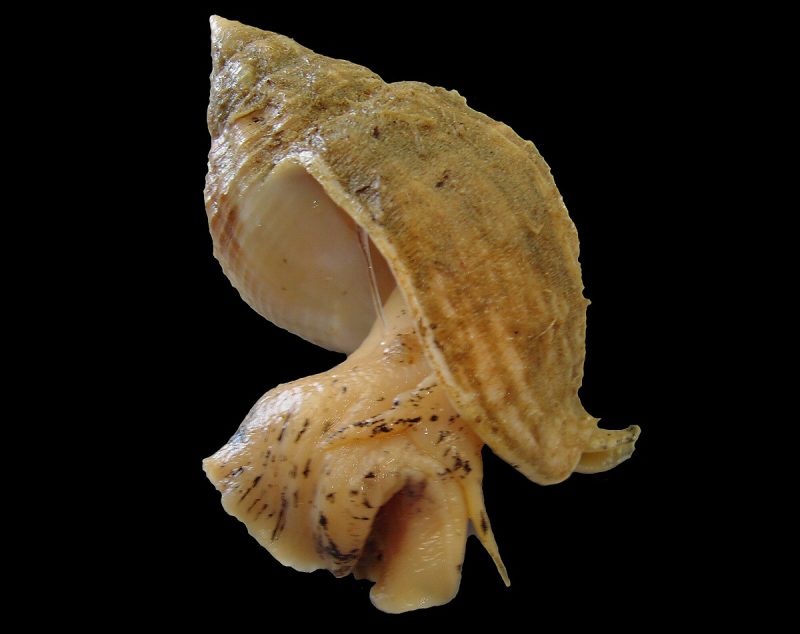Whelk

© Hans Hillewaert / , via Wikimedia Commons
Scientific name: Buccinum undatum
Also known as: Common Whelk
MCRS: 45mm at the longest part of the shell
Description
Whelks are large gastropod molluscs that can reach 10cm in height and 6cm in width. The shell morphology and colour can be highly variable depending on location. The shell has 7-8 whorls with spiral ridges. They have an oval aperture which tapers to a point with a short wide siphonal canal from the base of the aperture.
Habitat and Distribution
Whelks are commonly found on all British coasts, mainly sub-tidally down to 1200m. They are occasionally in the intertidal; however do not adapt well to life here as they cannot tolerate low salinities or desiccation from exposure to air. They are found on a variety of hard and soft substrates including muddy sand, gravel and rock. In softer sediment they can spend some time in burrows with their siphons protruding.
Their distribution ranges from Iceland and Norway down to the Bay of Biscay and throughout the north Atlantic.
Life Cycle, Reproduction and Feeding
Whelks are carnivorous predators and active scavengers. They use chemo-sensors to sense food in the water. When searching for food they extend a tube (siphon) to funnel water into the gill which connects to a sensory organ. Prey includes polychaete worms and small bivalve molluscs including cockles.
Whelk size at sexual maturity varies depending on the population. Spawning takes place from October-May, copulation occurs and once fertilised, females move to hard substrate such as rocks, shells or stones to attach eggs. The eggs are inside protective lens shaped capsules which are stuck together in a sponge like mass. Each capsule can contain up to 1000 eggs and up to 2000 capsules can be laid by a female. You can often see these empty egg capsules washed up on shores and beaches around the coast. Several females will group capsules together but not all will develop; some will act as food for growing embryos. Development occurs within the capsules until fully formed whelks hatch out in winter after around 4-5 months. There is no planktonic larval stage in the whelks reproductive strategy; therefore dispersal potential of this species is low. This factor, coupled with a limited range of movement as an adult, means that populations can be isolated into small geographical areas.
Additional Information
Whelks are not tolerant of warm temperatures; >29°C is lethal. They form prey for many species including cod, dogfish, rays, flatfish and starfish. Whelks are particularly vulnerable when caught in trawls and discarded as they can become disorientated; studies have shown predation on disorientated whelks is significant. Species, such as hermit crabs, use empty whelk shells to live in and need increasingly larger shells as they grow. It is important for many sizes of shell to be available in any given area.
In the NWIFCA District
Commercial fishing for whelks in the District occurs at low numbers at present; however there has been an increasing interest in this species.
Whelks are fished using pots; these can be recycled plastic containers, which are weighted to stay on the sea floor. Pots are set in strings, attached to one another, and baited with species such as dogfish or brown crab. Whelks are attracted to the pots by the scent of the bait. Pots can be left on the sea floor and hauled at intervals (1-3 days), then re-baited and set again. A small proportion of whelk catch is taken as bycatch in other fixed gears such as crab and lobster pots.
Fisheries Management
Whelks have a long life span, this coupled with a lack of mobility and dispersal between populations makes the whelk vulnerable to overfishing. If overfishing occurs population recovery would take a long time. The Blue Marine Foundation have published a study into whelk fisheries which details the needs for management of whelk fisheries. You can find the study on the Blue Marine Foundation website here.
If you do not possess a current licence to fish for whelks commercially there are Byelaws in place to regulate recreational whelk fishing. These include restrictions on the amount of gear used to fish, and a daily limit on the amount caught. There are also regulations for those fishing commercially including requirements for marking gear. These vary in different parts of the district. Find out more here.
Where commercial potting occurs in Marine Protected Areas it undergoes an assessment to ensure the activity does not cause risk to conservation features. HRAs carried out for potting in the District’s European Marine Sites can be found here.